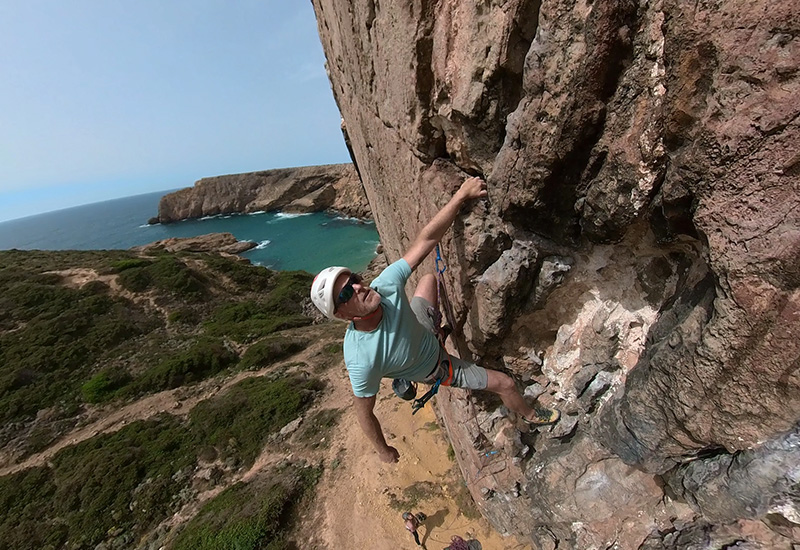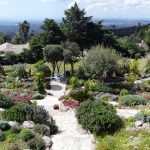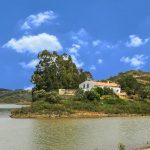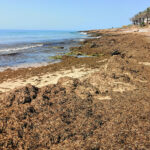The atmosphere was tense. The temporary stands were overflowing. Several spectators found seats either on the floor or on top of a two-metre-thick safety mat. The smell of chalk and rubber filled the air. A Portuguese emcee rattled off information about the upcoming finals at the first and only climbing gym in the Algarve – Vertical Escalada in Lagoa.
When I arrived just before the last challenge began, the 4.5-metre-high wall with six of the most challenging routes to the top was empty. As is typical for a climbing competition, the athletes competing for the top places were in what’s referred to as ‘isolation’. In order to avoid any unfair advantage, they are all forbidden from seeing the route (fluorescent plastic holds screwed into the wall) before their four-minute timer begins. Men and women are given different routes to complete, but no one is allowed to see what they will have to climb before they step onto the mat.
At 5 pm, the first climber emerged. He managed to make it to the first point hold but not all the way to the top. The crowd cheered him on as he hung precariously from one of the hot pink plastic pieces, but it was simply not possible. One by one, the men took their turns before the women began to test their skills. Few made it to the top and held on for the required two seconds. Several were able to score points at halfway holds along the way. But even for the top climbers in Portugal, many of whom climb professionally, these routes were difficult.

Rafael Kenji at full stretch in the Men’s finals © Guilherme Costa
For most climbers, in fact, these incredibly challenging routes would be beyond their capability. The strength required to pull your body up as you angle your weight onto a single hand upside down and then swing to another hold as you jump for the next plastic boulder is massive. Beyond the strength required throughout the entire body, successful climbers know how to use momentum to swing their weight across seemingly impossible gaps. They practise using more technique and less strength. They cross-train by lifting weights and doing cardio. To maintain the combination of strength, balance and flexibility needed to climb, most successful athletes climb at least four times a week or every other day.
For Maya Wheeler, a fifteen-year-old climber and expat who attends Vale Verde International School in Burgau, the biggest reason she loves climbing is actually surprising. It’s not the great fitness levels or the adrenaline rush, or the attention she gets from being the top climber in Portugal for her age group. “For me, it’s really social,” she explains. “I go to see my friends at Vertical. It’s a lot of fun to climb together and it’s my favourite place to hang out.”
Maya, who is half Spanish and half American, is also focused on learning Portuguese. The climbing gym has given her a way of meeting locals, which is otherwise relatively challenging for expats. Competing together has formed close bonds and Maya says she has been accepted into the local scene.
Perhaps another unexpected advantage to climbing – other than the absolutely amazing fitness benefits – is the cost. Climbing is a relatively inexpensive sport. For some climbers the gym offers all the climbing they need, while others use it for training and when it’s bad weather outside. On sunny days, like we have most of the year here in the Algarve, climbing on outdoor routes is practically free.
All you need are your climbing shoes, a rope, a harness, some carabiners and a good belayer below to catch you if you fall. Gym climbing requires even less gear, just a pair of climbing shoes and some chalk for your fingers.
Unlike horseback riding or tennis, this sport is accessible to most income levels because it requires so little gear. Even the gym membership at Vertical Escalada is not expensive compared to a regular gym, and you can pay per time (7€) or monthly (25€), which makes things even more budget-friendly.

Valter, Esther (Giulidori), and Maya at the competition © Justin Wheeler

Maya heel-hooking to stay connected to the wall © Saul at Showcase Productions
Founded in 2014 by two sets of brothers (Nuno and Ricardo Sacramento and Tiago and Valter Guerreiro) who are all avid climbers, Vertical Escalada has been a major catalyst for the climbing scene here in the Algarve. Nuno explains, “Although climbing has been a huge sport in Spain for the last 30 years, it’s relatively new here. The only indoor climbing gym in the Algarve, Vertical Escalada, has been a big part of the growth of the local climbing community. Over the last decade, the number of climbers has increased and the climbing tourism to the Algarve has also expanded.”
“Although the Algarve is mostly flat and without large mountains, we do have some very good rock climbing here, especially Rocha da Pena which has lots of routes for all levels and excellent rock quality,” says Valter. “If you are an experienced climber who wants adventure, Sagres has spectacular cliff climbing over the Atlantic Ocean. It is breathtaking. One of the main benefits of climbing here is the 300+ days of sunshine, so almost every day is a climbing day.”

Two of the finalists working the last boulder problems © Justin Wheeler
“Having Vertical Escalada here is what makes the sport accessible,” says Maya’s father, Justin Wheeler, a California native who is a filmmaker and extreme sports aficionado. “It gives people a place to go where they can gain the confidence and rope skills they need to go outside.” As Justin points out, although climbing is a sport that just about anyone can afford and do, it is important to learn the basics before you go freestyling out on a cliff by yourself with some rope. It is still a relatively dangerous sport and it’s important to fully respect the safety parameters.
The world-renowned cliffs of Sagres, for example, are only recommended for expert climbers. Here in the Algarve, the three largest climbing areas are Rocha de Pena, Albufeira and Sagres.
“Most people aren’t doing what Alex Honnold did at El Capitan in Free Solo with no ropes,” explains Justin. There are, however, some cliff climbs here in the Algarve where you can climb over water up to eight metres. So if you fall, you land in the water below. Not for the faint of heart, it’s still far less dangerous than free climbing in Yosemite.
Perhaps another reason why climbing, both indoor and outdoor, has experienced a boom in recent years is its official entry into the Olympic Games. With its debut in 2020 in Tokyo, which was delayed to 2021 due to the pandemic, rock climbing has finally gained the recognition it deserves as a sport.



Valter Guerreiro climbing a cave along the Algarve coast © Justin Wheeler
At the Olympics, climbers compete in three different areas – bouldering, lead and speed. Bouldering, in which climbers have four minutes to reach the top of a 4.5-metre-high wall, is made up of indoor routes. Technically and tactically challenging, it also tests strength, agility and a climber’s ability to solve problems, namely the best way to reach the top quickly. For lead, climbers have six minutes to go as high as possible on a 15-metre-tall wall.
Maya admits that her first competition was terrifying because she had no idea so many people would be watching her try to climb such difficult routes, screaming and cheering behind her. But watching her scale the walls this past November, she already looked like a pro. Grouped with the top professional climbers in Portugal, she is welcomed into the group despite her young age. Today she holds the top place for women in her age group in Portugal (under 16) and has placed in the women’s finals in each of the national competitions she competed in – even against professional climbers, many of whom are twice her age.
Ever since she started climbing with her parents at around age three, Maya has been climbing for fun. But it wasn’t until last year that she got serious about it and started to compete. “After I started going to Vertical, I really started to like climbing and get more serious about it. Also, Nuno and the Vertical team have been helping me train for the competitions, which I am very thankful for,” she says. “I also like the people there and I made so many friends that this is what really keeps me going.”

Valter, Nuno and Tiago celebrating their successful climbing competition © Sofia Oliveiro Pinto
When it comes to competitions, Maya’s weakest point at the moment is climbing routes that require what’s called ‘dynamic’ climbs. These moves require the climber to literally swing their bodies and jump in order to reach the next hold. Nevertheless, at just fifteen, Maya’s strength, determination and perseverance have got her to the top in Portugal for her age group. If she continues to train, there’s no doubt she has far higher to climb.
On the first Monday of each month, the local climbers get a chance to compete against each other at Vertical Escalada’s Boss Day. New routes are set and everyone gets a chance to try them for the first time in a friendly event. So what are you waiting for? If you’ve been craving the chance to climb some walls other than the ones you have at home, here’s your chance!
www.instagram.com/vertical.gym













